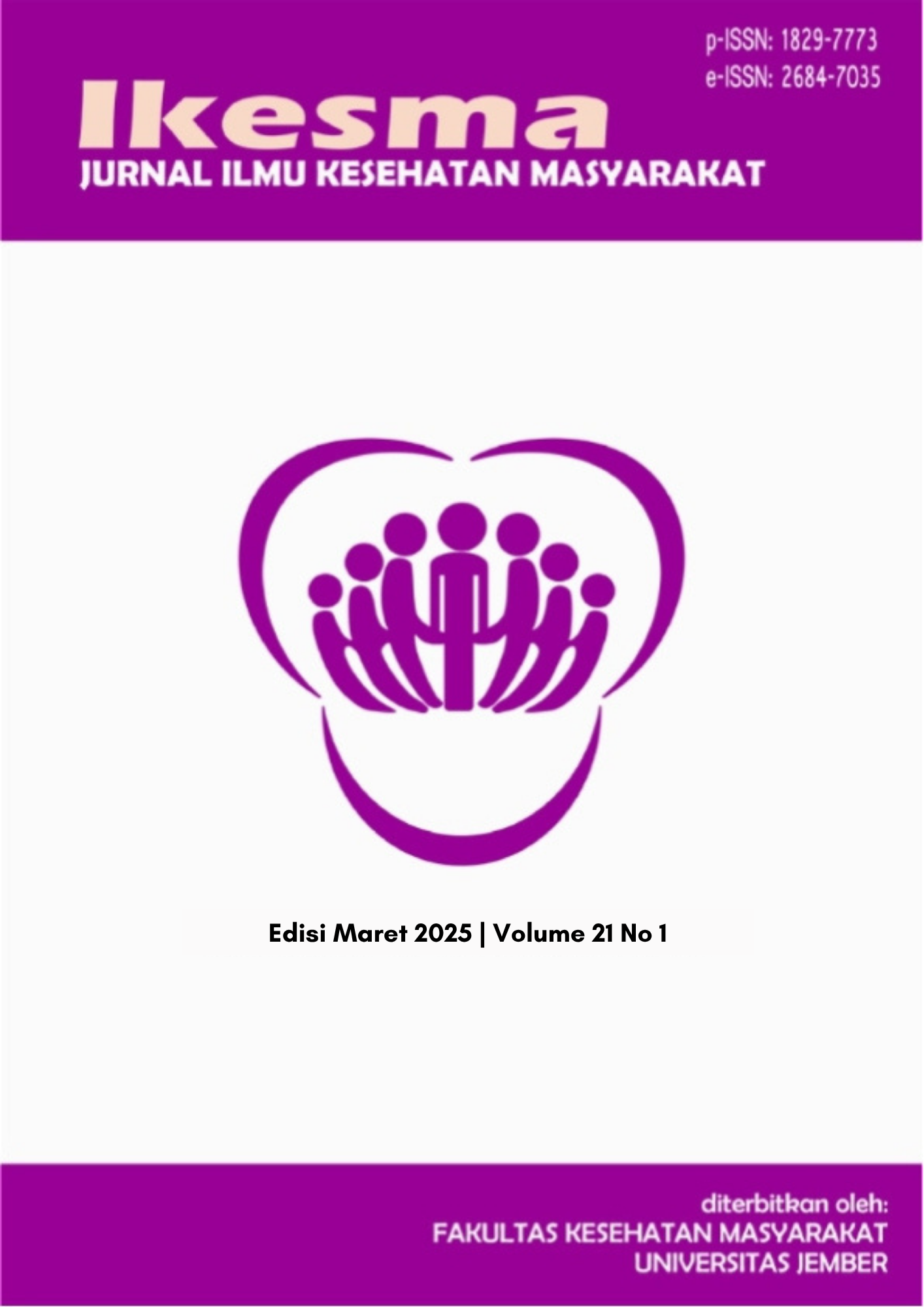THE EFFECT OF HEALTH EDUCATION TROUGH SOCIAL MEDIA ON SAFETY BEHAVIOR AMONG MIDWIVES TOWARD SAFE AND HEALTHY CHILBIRTH PROCESS
DOI:
https://doi.org/10.19184/ikesma.v21i1.49050Keywords:
Health Education, Safety Behaviour, Occupational DiseasesAbstract
The greatest risk factor for transmission occurs between pregnant women and children, both during childbirth and in infancy, with a risk factor of up to 99%. Neonatal intervention will reduce the risk of transmission from 95% to <5%. Safety behavior is proven to have an important role in preventing work accidents and PAK, because good safety behavior will prevent exposure to danger to health workers, including midwives. Injuries, illnesses and even deaths are mostly caused by health workers not implementing safety behavior, which is also increasingly exacerbated by dangerous work systems and environments. The importance of knowledge about safety behavior such as the use of PPE and compliance with SOPs can be seen from the very high prevalence of accidents and PAK. Safety behavior that is classified as low has an impact on health workers being exposed to disease and experiencing work accidents. The development of social media with infographics, images and video content is a phenomenon that needs to be utilized to implement safety behavior. The high number of social media users has the potential to be used as educational media, including Health Education. This research aims to see the impact of health education through social media on the safety behavior of midwives towards a healthy and safe birth process, so that it can be seen how much impact the safety education provided has on aspects of knowledge, attitudes and behavior. This type of research is a true experiment using a pre-test and post-test research design. The population of this study was 86 people and the sample size was 60 people. The independent variable in this research is health education and the dependent variable is safety behavior. Research data was analyzed using paired t-test with SPPS.25. The results of this study show that health education significantly influences the safety behavior aspects of respondents which include the level of knowledge of SOPs, the level of attitude towards compliance with SOPs, knowledge of PPE and the level of compliance with the use of PPE (p value = 0.000).
Downloads
References
1] Afandi A. Hubungan pengetahuan dan sikap tenaga kesehatan dengan perilaku penggunaan alat pelindung diri di masa pandemi COVID-10 di RSUD X (Thesis) Universitas Hasanuddin Makasar;2020
2] Andriani. 2019. Risiko ergonomi low back pain bidan dalam menolong persalinan pada bidan praktik mandiri. Jurnal Ilmiah Bidan. 4(1):9–13.
3] Budian dan Riyanto.2018. Jurnal pengaruh antara internal locus of control dan iklim keselamatan terhadap perilaku keselamatan. International Confederation of Midwives. 2017. International definition of the midwife. International Confederation of Midwives. 3.
4] Carayon, P. and J. C. Alvarado. 2015. Patient Safety and Quality: An Evidance-Based Handbook for Nurses. Chapter 39. Personal Safety for Nurses. Rockvile: Agency for Healthcare Research Quality ({US}). 39
5] Dodoo, J. E. and H. Al-Samarraie. 2019. Factors leading to unsafe behavior in the twenty first century workplace: a review. Management Review Quarterly. 69(4):391–414.
6] Dharma, K. K. 2015. Metodologi Penelitian Keperawatan. Edisi 5. Jakarta Timur: CV. Trans Info Media, Jakarta Timur.
7] Dharma, S. dan R. Hidayat. 2020. Pendidikan Kesehatan. Yogyakarta: Pustaka Pelajar.
8] Fitriyah, Y. 2017. Analisis pemanfaatan berbagai media sosial sebagai sarana penyebaran informasi bagi masyarakat. Paradigma - Jurnal Komputer dan Informatika. 19(2):152.
9] Firmasyah.2017. Pengaruh penggunaan video pembelajaran terhadap prestasi praktik pemesinan di smk muhammadiyah prambanan. Pendidikan Teknik Mesin. 3(7):511–518.
10] Hu, Y., Q. Li, and Y. Chen. 2018. Evaluation of two health education interventions to improve the varicella vaccination: a randomized controlled trial from a province in the east china. BMC Public Health. 18(1):144
11] Kepios. 2022. Digital 2022: Indonesia. https://datareportal.com/reports/digital-2022-indonesia
12] Mayangkara, R. H., A. A. Subiyanto, and D. G. Tamtomo. 2021. Implementation of hospital occupational health and safety regulations to minimize occupational accidents at the sultan agung islamic hospital, semarang. Journal of Health Policy and Management. 6(3):160–167.
13] Nurhidayah. 2021. Safety education (pendidikan keselamatan) di sekolah menengah atas. Higeia Journal of Public Health Research and Development. 4(3):359–370.
14] Pham, T. T. H., T. X. Le, D. T. Nguyen, C. M. Luu, B. D. Truong, P. D. Tran, M. Toy, S. Bozkurt, dan S. So. 2019. Knowledge, attitudes and medical practice regarding hepatitis b prevention and management among healthcare workers in northern vietnam. PLoS ONE. 14(10):1–14.
15] Paramita, E.,Martini, E., & Roshetko, J.M (2013). media dan metode Komunikasi dalam penyuluhan agroforesti : studi kasus di sulawesi selatan. In World Agroforestry Centre (ICRAF) (pp.488-493).
16] Ulya, Iskandar. 2020. HE EFFECT OF OCCUPATIONAL SAFETY AND HEALTH TRAINING ON SAFETY BEHAVIOR OF WORKER IN WOLASI PUBLIC HEALTH CENTER, SOUTH KONAWE REGENCY. Universitas Hasanuddin.
Downloads
Published
Issue
Section
License
Copyright (c) 2025 Zainur Ismail, Anita Dewi Prahastuti Sujoso, Sugeng Winarso

This work is licensed under a Creative Commons Attribution-ShareAlike 4.0 International License.



